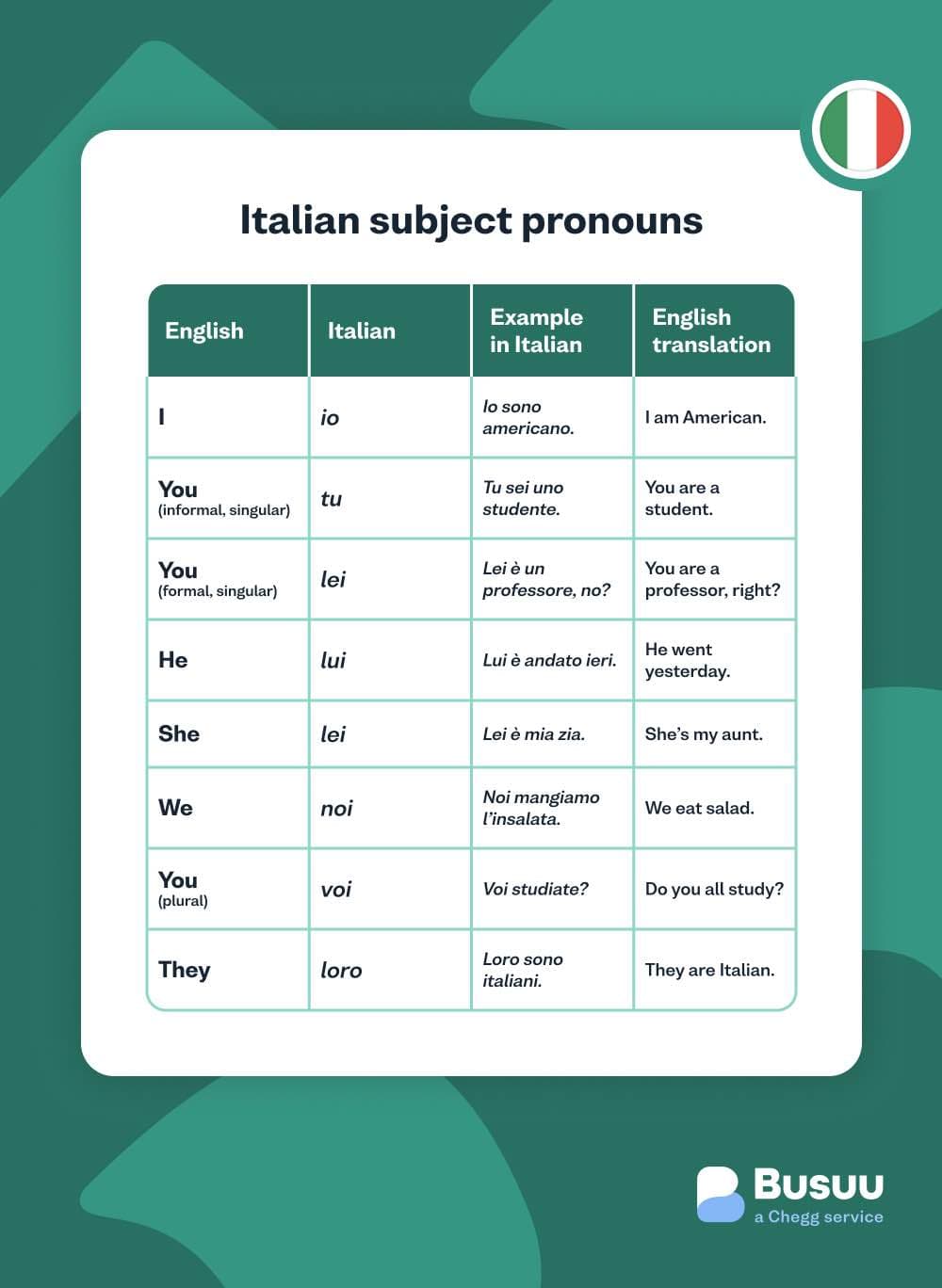I want to learn...
Italian pronouns go in place of a noun (person, place or thing) in a sentence. In English, some examples are: “you”, “I”, “her”, “his” or “them”.
We use pronouns because it makes sentences sound less repetitive. Imagine someone says, “Oh, speaking of John, I talked to John yesterday. John says hi and that John wants to go to the movies together on Friday.” Doesn’t that sound weird? It’s much more natural to say, “Oh, speaking of John, I talked to him yesterday. He says hi and that he wants to go to the movies together on Friday.”
The basics of Italian pronouns
In Italian, we use pronouns similarly for people, objects, and more.
There are six types of pronouns in Italian:
Subject pronouns
Direct object pronouns
Indirect object pronouns
Possessive pronouns
Reflexive pronouns
Relative pronouns
Let’s start with the first one, subject pronouns.
Italian subject pronouns
Subject pronouns, as you might guess, replace the subject of a sentence. These replace names, so instead of saying “your friend, Maria”, you would say “lei”.

Italian subject pronouns
| English | Italian | Example in Italian | English translation |
|---|---|---|---|
| I | io | Io sono americano. | I am American. |
| You (informal, singular) | tu | Tu sei uno studente. | You are a student. |
| You (formal, singular) | lei | Lei è un professore, no? | You are a professor, right? |
| He | lui | Lui è andato ieri. | He went yesterday. |
| She | lei | Lei è mia zia. | She’s my aunt. |
| We | noi | Noi mangiamo l’insalata. | We eat salad. |
| You (plural) | voi | Voi studiate? | Do you all study? |
| They | loro | Loro sono italiani. | They are Italian. |
What’s important to know about subject pronouns
1. Native Italian speakers often drops subject pronouns
Why? Because, in Italian, the verbs are conjugated (changed) according to each subject.
In English, “I speak Italian” requires the “I” because otherwise, we have no clue who speaks Italian.
But in Italian, that sentence would look like “parlo italiano”. Parlo is the “I” form of parlare (to speak), so with or without the subject, we know the subject is “I”.
There are always exceptions, though: for instance, if you use the word anche (also, too), then you must put the pronoun back into the sentence:“Anche io parlo italiano.”
2. Unlike English, Italian has a formal pronoun,lei
It’s a polite way to address elder people, professors, or anyone with a higher position than you or that you’re not familiar with.
Don’t be confused, it looks exactly like the pronoun for “she” but lei (formal you) can be used for both men and women. It’ll follow the third person conjugation.
Example: Signor Rossi, lei ha molta fame? (Mr. Rossi, are you very hungry?)
Italian direct object pronouns
Just like how subject pronouns replace their subject, an Italian direct object pronoun will replace a direct object. What is a direct object? They’re the direct recipient of a verb.
There are two ways to know if an object is direct:
The object doesn’t have a preposition (to, a, in, etc.) in front of it.
The object can answer the question “What?” or “Who?”
Who are you calling? I’m calling Maria.
What are you selling? I’m selling a sofa.
Here are two English example sentences featuring direct objects. To replace them with direct object pronouns, we’d say:
Who are you calling? I’m calling her.
What are you selling? I’m selling it.
Direct object pronouns in Italian
| English | Italian (weak/strong form) | Example in Italian | English translation |
|---|---|---|---|
| me | mi/me | Mi capisci? Ha chiamato me, ma preferisce te. | Can you understand me? She called me, but she prefers you. |
| you | ti/te | Ti ho accompagnato a casa. | I accompanied you home. |
| him/it | lo/lui | Il mio amico lo ha visto la settimana scorsa. Io conosco lei, non lui. | My friend saw him last week. I know her, not him. |
| her/it | la/lei | Anche mia madre la conosce! | My mom knows her too! |
| us | ci/noi | L'insegnante ci ha puniti. Il ladro ha aggredito noi, non voi. | The teacher punished us. The robber attacked us, not you. |
| you (plural) | vi/voi | Maria vi ha presentati a sua sorella. | Maria introduced you to her sister. |
| them | li (masculine) le (feminine) loro (both genders) | Li hai incontrati la settimana scorsa? Ha premiato loro e ci ha ignorati. | Did you meet them last week? He/she has rewarded them and ignored us. |
How to put direct object pronouns in a sentence
Here’s the break down:
Paola lava la camicia. (Paola washes the shirt.)
becomes
Paola la lava. (Paola washes it.)
In Italian, the direct object pronoun usually goes before the verb.
In English, we might say: “I try it.”
In Italian, you’d say, “Lo provo.” (Literally: it I try.)
But there are some cases where you can join the direct object pronoun after the verb. This is the case when you have a verb in its infinitive, imperative, or gerundive form.
Posso mangiare la pasta (I can eat the pasta.)
Posso mangiarla.Chiamalo! (Call him!)
Puoi aprire la busta tagliandola. (You can open the envelope by cutting it.)
Just like the articles, when lo or la are followed by a vowel or “h”, they can change to l’. This often happens when they are followed by a form of the verb“(e.g. ho, hai, ha, abbiamo, avete, hanno).
Lo ho perso (I lost it) – uncommon
L’ho perso.– more common
Italian indirect object pronouns
Good news! Indirect object pronouns are actually extremely similar to their direct object pronoun counterparts, with the only change being in the third person singular.
Instead of answering “who?” or “what?” like direct object pronouns do, these indirect object pronouns answer the questions “to whom?” or “to what”?
To whom do you give the present? I give the present to Laura.
A quick and easy way to tell if an object is direct or indirect is to see if the preposition “a” precedes it or if we can answer the questions “To whom? / To what?”.
Do il regalo a Laura. (I give the present to Laura).
Le do il regalo. (To whom I give the present? I give the present to her.)
Indirect object pronouns
| English | Italian (weak/strong form) | Example in Italian | English Translation |
|---|---|---|---|
| to me | mi/me | Mi hai portato il cibo? Hai portato il cibo a me | Did you bring the food to me? |
| to you | ti/te | Ti offro il posto. Offro il posto a te. | I offer the seat to you. |
| to him | gli/lui | Gli spiegherai il libro? Spiegherai il libro a lui? | Will you explain the book to him? |
| to her | le/lei | Le dica che l’ufficio è chiuso. Dica a lei che l’ufficio è chiuso. | Tell her that the office is closed. |
| to us | ci/noi | Ci hanno riservato un posto. Hanno riservato un posto per noi. | They saved a spot for us. |
| to you (plural) | vi/voi | Vi ha detto qualcosa? Ha detto qualcosa a voi? | Did he/she say something to you? |
| to them | loro, gli/loro | Gli ho detto di smettere. Ho detto di smettere a loro. | I told them to stop. |
The “them” indirect object pronouns gli and loro are interchangeable, but loro will always go after the verb.
Gli ho detto di smettere. (I told them to stop.)
Ho detto loro di smettere.
Pro-tip: Another way to create an indirect object pronoun in Italian is with a+ the strong form of the direct object pronoun (see above). For example, a lei (to her) and le mean the same thing, but a lei has a stronger emphasis.
Last thing on indirect object pronouns--they can also attach to the end of a verb in the case of an infinitive, gerundive, or imperative.
Puoi dirle. (You can tell her.)
Parlagli! (Talk to him!)
Italian possessive pronouns
How do you say mine, yours, hers, etc. in Italian?
Luckily, Italian possessive pronouns are the same as Italian possessive adjectives. But unlike their adjective counterparts, possessive pronouns replace the noun that someone or something possesses.
Italian possessive pronouns
| English | Italian pronouns Masculine singular | Italian pronouns Feminine singular | Italian pronouns Masculine plural | Italian pronouns Feminine plural |
|---|---|---|---|---|
| mine | mio | mia | miei | mie |
| yours | tuo | tua | tuoi | tue |
| his/hers | suo | sua | suoi | sue |
| ours | nostro | nostra | nostri | nostre |
| yours | vostro | vostra | vostri | vostre |
| theirs | loro | loro | loro | loro |
Italian possessive pronouns agree in gender and number with the noun they’re replacing, except for loro, which stays the same no matter what.
Questa sedia è mia, non tua! (This chair is mine, not yours!)
Il libro non è nostro, è loro. (The book isn’t ours, it’s theirs.)
Congratulazioni per la casa, è tutta vostra! (Congratulations on the house, it’s all yours!)
Reflexive pronouns in Italian
Reflexive pronouns or pronomi riflessivi pair with reflexive verbs. Fortunately, they look just like direct object pronouns, except for si in the singular and plural third person.
They function similarly to how “myself”, “yourself”, “ourselves”, etc. work in English. They demonstrate that the object reflects back onto the subject, hence their name.
Reflexive pronouns
| English | Italian |
|---|---|
| myself | mi |
| yourself | ti |
| himself | si |
| ourselves | ci |
| yourselves | vi |
| themselves | si |
As with direct and indirect object pronouns, these go before the verb or after an infinitive.
Mi lavo le mani. (I wash my hands.)
Lei sipettina i capelli. (She brushes her hair.)
Vogliono svegliarsi prima. (They want to wake up earlier.)
Quanto spesso dobbiamo lavarci i denti? (How often should we brush our teeth?)
Italian relative pronouns
Relative pronouns don’t have any exact meaning by themselves. Their job is to connect sentences. They’re similar to how “who” or “that” works between two clauses in English.
There are two types of relative pronouns:
Invariable relative pronouns (those that don’t change)
Variable relative pronouns (those that do change)
Let’s look at two invariable pronouns: che and cui.
Che(who, that) replaces a subject or direct object (remember: a person, animal or thing).
La persona che incontrerò più tardi è un amico. (The person that I’m meeting later is a friend.)
Ricordate l’uomo che ci ha parlato ieri? (Remember the guy that spoke to us yesterday?)
Cui do esn’t have one specific translation, rather it works with a preposition (a, in, etc.) to act like an indirect object.
L’ultimo posto in cui ho lavorato era in questa zona. (The last place where I worked was in this area.)
Questo è il parco in cui ho visto il festival l’anno scorso. (This is the park where I saw the festival last year.)
La persona a cui ho parlato non è più qui. (The person I spoke to is no longer here.)
Cui can also mean “whose” if it has the definite articles il, i, la or le before it.
Maria, il cui capo è anche il mio, lavora in un altro edificio. (Maria, whose boss is also my boss, works in a different building.)
Meanwhile, variable pronouns have the same functions as the above invariable pronouns but they will change depending on the noun’s gender and number:
Variable relative pronouns
| Masculine singular | Masculine plural | Feminine singular | Feminine plural |
|---|---|---|---|
| il quale | i quali | la quale | le quali |
La donna con la quale lavorava era mia madre. (The woman that he/she worked with was my mother.)
Gli uomini con i quali avete parlato prima vengono a cena. (The men you talked with earlier are coming to dinner.)
You did it! While this is a lot of information to process, understanding the fundamentals of Italian pronouns will help you as you continue to progress in your language learning journey.
If it seems overwhelming, remember that practice will ensure you internalize each of these pronouns until it becomes second nature. At Busuu, we are committed to helping language learners reach their learning goals. We know learning never ends, which is why we’re here to give you the resources you need to succeed!
Newlanguages


